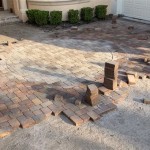Laying Flagstone Patio On Grass: A Step-by-Step Guide
A flagstone patio is a beautiful and durable addition to any backyard, blending seamlessly with the natural surroundings. Laying flagstone directly on grass offers a unique charm, allowing the patio to emerge organically from the landscape. This approach eliminates the need for extensive excavation, making it a more environmentally friendly and cost-effective option. However, it requires careful planning and execution to ensure a stable and long-lasting result.
1. Planning and Preparation
Before embarking on the project, meticulous planning is essential. First, determine the desired size and shape of the patio. Consider the surrounding landscaping and existing features to create a cohesive design. Next, carefully mark out the patio area using stakes and string. This provides a visual guide during the installation process and helps ensure an even and symmetrical layout. Once the boundaries are defined, it's important to remove any existing vegetation within the designated area. This involves clearing away grass, weeds, and any other plants that might interfere with the flagstone installation.
Once the area is clear, it's time to prepare the ground. The ideal base for a flagstone patio on grass is a compacted layer of gravel. This provides drainage and prevents the flagstones from sinking into the soil. Dig out a layer of soil approximately 4-6 inches deep, depending on the thickness of the flagstones. Then, fill the excavated area with gravel, ensuring it is evenly distributed and compacted to create a firm foundation. A layer of landscape fabric can be installed on top of the gravel to help prevent weed growth through the gaps between the flagstones.
2. Laying the Flagstones
With the base prepared, the fun part begins: laying the flagstones. Start by arranging the flagstones in the desired pattern. Consider using a dry-set method, which allows for easy adjustment before the mortar is applied. For a natural look, avoid placing the flagstones in a perfectly symmetrical grid. Instead, opt for a more organic arrangement, with slight variations in spacing between the stones. This adds visual interest and complements the surrounding landscape. As you lay each flagstone, use a rubber mallet or a piece of scrap wood to tap them into place, ensuring they are level with each other.
Once you are happy with the arrangement, it's time to secure the flagstones. A thin layer of mortar is applied to the gravel base, and the flagstones are placed on top. Use a level to ensure each stone is perfectly level. Allow the mortar to cure for at least 24 hours before applying any weight to the patio. Once the mortar has set, you can fill the gaps between the stones with sand or a polymeric sand. This helps prevent weeds from growing and adds to the overall aesthetic appeal of the patio.
3. Finishing Touches
After the flagstones have been laid and the gaps filled, the final step is to enhance the patio's appeal. Consider adding a border of edging stones or pavers to define the patio area and prevent the flagstones from shifting. You can also install outdoor lighting to create a warm and inviting ambiance in the evenings. For a truly personalized touch, arrange outdoor furniture, planters, or other decorative elements to complete the design.

How To Lay A Flagstone Walkway In An Existing Lawn

How To Set Flagstone In Grass Hunker Walkway Landscaping Garden Pavers Design

How To Lay A Flagstone Walkway In An Existing Lawn

How To Install A Flagstone Patio

How To Lay A Flagstone Walkway In An Existing Lawn

Flagstone Patio Ideas Cost How To Install Landscaping Network

How To Install A Dry Lay Patio Stone Depot

How To Install Pavers Installing A Patio Step By Guide

8 Ways To Use Flagstone In Your Landscaping Lawnstarter

Flagstone Patio Questions Outdoor Board








